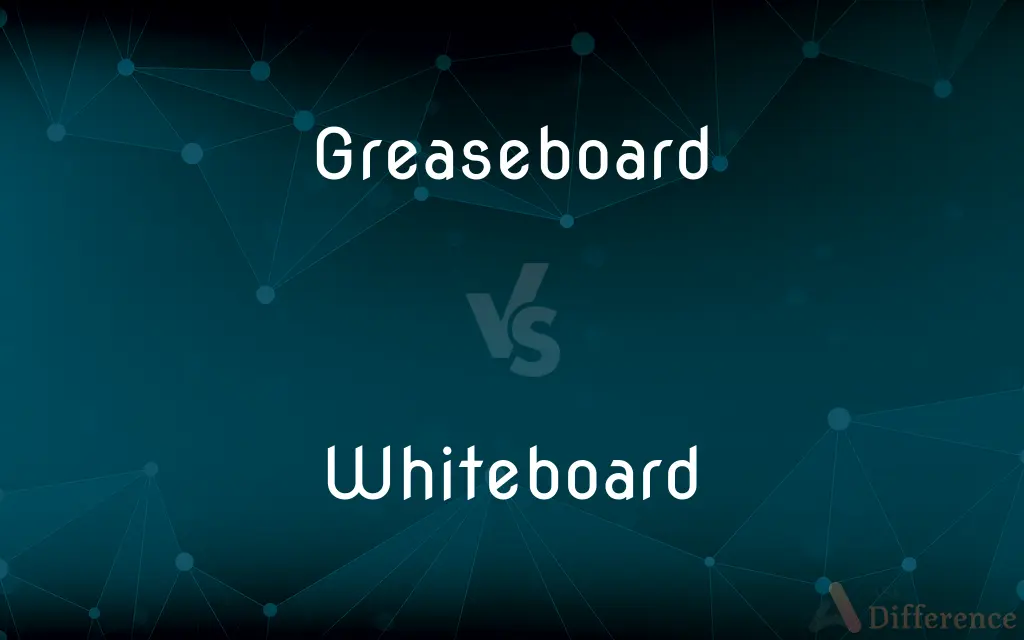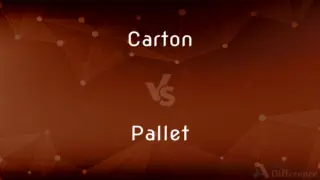Greaseboard vs. Whiteboard — What's the Difference?
Edited by Tayyaba Rehman — By Urooj Arif — Updated on March 8, 2024
Greaseboards, now rare, require oil-based markers for writing, offering a glossy finish, whereas whiteboards, widely used, work with dry-erase markers, providing ease of use and cleaning.

Difference Between Greaseboard and Whiteboard
Table of Contents
ADVERTISEMENT
Key Differences
Greaseboards are an older form of writing surface that use a glossy, often harder surface, compatible with oil-based markers. In contrast, whiteboards have become the standard in classrooms, offices, and other settings, known for their smooth, matte finish that works with dry-erase markers.
The term "greaseboard" sometimes refers to early versions of whiteboards or specific types that required greasy substances for writing, making them less common in today's settings due to the inconvenience of cleaning and maintaining them. Whiteboards, on the other hand, are designed for easy erasure, often requiring just a simple swipe with a cloth or eraser, which has contributed to their widespread adoption.
One of the main differences lies in the materials used for both the boards and the markers. Greaseboards, with their reliance on oil-based markers, can lead to smudging and are harder to clean, requiring special solvents. Whiteboards use water-based dry-erase markers that are easier to wipe away, making them more suitable for frequent and fast-paced use.
In terms of visual clarity and ease of reading, whiteboards often provide a better experience. The matte finish reduces glare, making it easier to see from different angles and lighting conditions. Greaseboards, with their glossy finish, can reflect light more, which might hinder visibility in brightly lit environments.
Despite these differences, both boards serve the fundamental purpose of providing a reusable writing surface. Greaseboards might still be found in some niche applications where their specific characteristics are desired, while whiteboards have become ubiquitous in educational and professional environments due to their convenience and functionality.
ADVERTISEMENT
Comparison Chart
Writing Medium
Oil-based markers
Dry-erase markers
Surface Finish
Glossy
Matte
Ease of Cleaning
Requires solvents, harder to clean
Easy to clean with a dry cloth or eraser
Popularity
Rare, mostly replaced by whiteboards
Widely used in various settings
Visibility
Can have glare due to glossy finish
Matte finish reduces glare, easier to read
Compare with Definitions
Greaseboard
An older writing surface for oil-based markers.
The garage still had an old greaseboard hanging on the wall.
Whiteboard
A writing surface designed for dry-erase markers.
We used the whiteboard for brainstorming during the meeting.
Greaseboard
Requires specific cleaning methods.
Cleaning the greaseboard needed a special solvent to remove the residue.
Whiteboard
Features a matte finish for better visibility.
The whiteboard's matte surface made it easy to see from afar.
Greaseboard
Known for its glossy finish.
The greaseboard's glossy surface reflected the overhead lights.
Whiteboard
Easy to clean and maintain.
A simple wipe was all it took to clean the whiteboard.
Greaseboard
Less common in modern settings.
Finding greaseboards has become a challenge with the rise of whiteboards.
Whiteboard
Supports quick and frequent updates.
The project plan was continuously updated on the whiteboard.
Greaseboard
Used in niche applications.
The artist preferred a greaseboard for its unique texture.
Whiteboard
Dominant in educational and professional environments.
Every classroom in the school was equipped with a whiteboard.
Greaseboard
A whiteboard.
Whiteboard
A whiteboard (also known by the terms marker board, dry-erase board, dry-wipe board, and pen-board) is a glossy, usually white surface for making nonpermanent markings (an evolved version of the blackboard). Whiteboards are analogous to blackboards, but with a smoother surface allowing rapid marking and erasing of markings on their surface.
Whiteboard
A panel covered with white, glossy plastic for writing on with erasable markers. Also called dry erase board.
Whiteboard
A writing board finished with a hard white material, which can be written upon using special non-permanent markers and subsequently wiped clean.
Whiteboard
A collaborative tool allowing several users to write and draw on the same shared display.
Common Curiosities
Is there a significant price difference between Greaseboards and Whiteboards?
The price can vary based on size and quality, but whiteboards are generally more available and may be more cost-effective due to their widespread use.
What makes Whiteboards ideal for classrooms and offices?
Their ease of cleaning, compatibility with dry-erase markers, and reduced glare make them ideal for frequent use in collaborative environments.
What is a Greaseboard?
A greaseboard is an older form of writing surface that uses oil-based markers and has a glossy finish.
How do you clean a Greaseboard?
Cleaning a greaseboard typically requires solvents to remove the oily residue left by markers.
Do Greaseboards and Whiteboards serve the same purpose?
Yes, both serve the purpose of providing a reusable writing surface, but with different materials and maintenance needs.
Can you use dry-erase markers on a Greaseboard?
No, dry-erase markers are not suitable for greaseboards, which require oil-based markers.
What is a Whiteboard?
A whiteboard is a smooth, matte-finished surface designed for use with dry-erase markers, making it easy to write on and clean.
What are the main advantages of Whiteboards over Greaseboards?
The main advantages include easier cleaning, less glare, and the use of non-toxic, odorless dry-erase markers.
Why are Whiteboards more popular than Greaseboards?
Whiteboards are more popular due to their ease of use, ease of cleaning, and the convenience of dry-erase markers.
Are Greaseboards still used today?
While rare, greaseboards may still be found in some niche applications where their specific features are preferred.
Can the surface of a Whiteboard become permanently stained?
Yes, if not cleaned regularly or if inappropriate markers are used, whiteboards can suffer from ghosting or permanent staining.
What are some alternative uses for Whiteboards in a creative setting?
Beyond writing, whiteboards can be used for drawing, brainstorming, planning, and as a tool in creative workshops and design thinking sessions.
How long do Whiteboards last?
With proper care and regular cleaning, whiteboards can last for many years without significant wear.
Can Greaseboards be refurbished?
Refurbishing greaseboards is possible but may require specialized materials to restore their surface.
Are there different types of Whiteboards?
Yes, there are various types, including magnetic whiteboards, mobile whiteboards, and interactive whiteboards, catering to different needs.
Share Your Discovery

Previous Comparison
Carton vs. Pallet
Next Comparison
Sabre vs. ScimitarAuthor Spotlight
Written by
Urooj ArifUrooj is a skilled content writer at Ask Difference, known for her exceptional ability to simplify complex topics into engaging and informative content. With a passion for research and a flair for clear, concise writing, she consistently delivers articles that resonate with our diverse audience.
Edited by
Tayyaba RehmanTayyaba Rehman is a distinguished writer, currently serving as a primary contributor to askdifference.com. As a researcher in semantics and etymology, Tayyaba's passion for the complexity of languages and their distinctions has found a perfect home on the platform. Tayyaba delves into the intricacies of language, distinguishing between commonly confused words and phrases, thereby providing clarity for readers worldwide.
















































